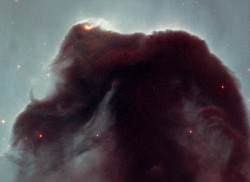Eleven years in orbit: Hubble observes the popular Horsehead nebula [heic0105]
24 April 2001
To celebrate its eleventh birthday, the NASA/ESA Hubble Space Telescope has released an unsurpassed picture of the famous Horsehead nebula in Orion. This dark nebula is part of the large Orion Complex, birthplace to thousands of stars.
 |
Rising from a sea of dust and gas like a giant sea horse, the Horsehead nebula is one of the most photographed objects in the sky. The American-European Hubble Space Telescope took a close-up look at this heavenly icon, revealing the cloud's intricate structure. This detailed view of the horse's head is being released to celebrate the orbiting observatory's eleventh anniversary on 24 April. Produced by the Hubble Heritage Project, this picture is a testament to the Horsehead's popularity.
The Horsehead, also known as Barnard 33, is a cold, dark cloud of gas and dust, silhouetted against the bright nebula, IC 434. The bright area at the top left edge is a young star still embedded in its nursery of gas and dust. Radiation from this hot star is eroding its gaseous birthplace. A massive star located outside Hubbles view is, in a similar fashion, sculpting the top of the Horsehead itself.
The nebulas unusual shape, roughly resembling the head of a horse, was first discovered on a photographic plate in the late 1800s. The Horsehead, located in the constellation Orion, is a cousin of the famous pillars of dust and gas known as the Eagle nebula. Both tower-like nebulae are cocoons of young stars.
The Horsehead nebula lies just south of the bright star Zeta Orionis, which is easily visible to the unaided eye as the left-hand star in the line of three that form Orion's Belt. Amateur astronomers often use the Horsehead as a test of their observing skills - it is known as one of the more difficult objects to observe visually with an amateur-sized telescope.
This popular celestial target was the clear winner among more than 5,000 Internet voters, who last year selected the Horsehead nebula as an astronomical target for the Hubble telescope to observe. The voters included students, teachers, and professional and amateur astronomers.
This image was composed by the Hubble Heritage Team, which superimposed Hubble data onto ground-based data (limited to small triangular regions around the outer edge of the image). Ground-based image courtesy of Nigel A. Sharp (NOAO/AURA/NSF) taken at the 0.9-meter telescope at the National Science Foundation's Kitt Peak National Observatory (NOAO/AURA) in Tucson, Arizona.
Image Credit: NASA, NOAO, ESA and The Hubble Heritage Team (STScI/AURA)
Facts
- The Hubble Space Telescope was launched by the shuttle Discovery (STS-31) on 24 April 1990 at 12:33:51 UTC
- Hubble was released by the Shuttle's robotic arm on 26 April at 19:38 UT
- Hubble is a joint American/European collaboration in which the observing time is shared 85%/15%
During its first 11 years of operation Hubble has:
- Orbited 60 000 times around the Earth
- Travelled more than 2600 million kilometres more than 17 times the distance to the Sun
- Made more than 400 000 exposures
- Observed 15 000 astronomical targets
- Downloaded more than 10 Terabytes of data to Earth
- Resulted in 11 000 scientific papers
Notes for editors:
Acknowledgement: K. Noll (Hubble Heritage PI/STScI), C. Luginbuhl (USNO), F. Hamilton (Hubble Heritage/STScI).
The Hubble Space Telescope is a project of international co-operation between ESA and NASA.
This news release is issued jointly by ESA (Hubble European Space Agency Information Centre) and NASA (Office of Public Outreach).
Contacts:
Lars Lindberg Christensen
Hubble European Space Agency Information Centre, Garching, Germany
Phone: +49-(0)89-3200-6306
Cellular (24 hr): +49-(0)173-38-72-621
E-mail: lars eso.org
eso.org
Dr. Keith Noll
Hubble Heritage Team, Space Telescope Science Institute
Phone: +001-410-338-1828
E-mail: noll stsci.edu
stsci.edu
Dr. Howard E. Bond
Hubble Heritage Team, Space Telescope Science Institute
Phone: 001-410-338-4718
E-mail: bond stsci.edu
stsci.edu

